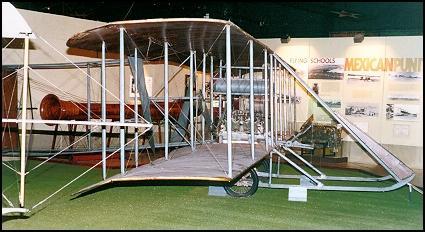|
This modified version of the Wright "B" Flyer, was the first model produced in quantity by the Wright Brothers. It is representative of Signal Corps Aeroplanes No. 3 and No. 4, purchased by the Army in 1911 and used for training pilots and in aerial experiments. At College Park, Md., in Oct. 1911, a Wright "B" was used for the first military trials of a bombsight and bomb-dropping device. The major modifications of this airplane are the installation of an eight-cylinder Rausenberger engine in place of the original four-cylinder Wright engine and the addition of ailerons on the trailing edges of the wings in place of the Wright's lever control system. The airplane on display was used for flight instruction by Mr. Howard Rinehart at Mineola, N.Y., in 1916. It appears here almost exactly as it did when it was last flown by Lt. John A. Macready during the International Air Races at Dayton, OH., in Oct. 1924 |
 |
|
|
SPECIFICATIONS Span: 39 ft. Length: 28 ft. Height: 8 ft. 9 in. Weight: 1,400 lbs. loaded Armament: None Engine: Eight-cylinder Rausenberger of 75 hp. Cost: $5000 PERFORMANCE Maximum speed: 45 mph. Maximum endurance: 2 hr.
|
||